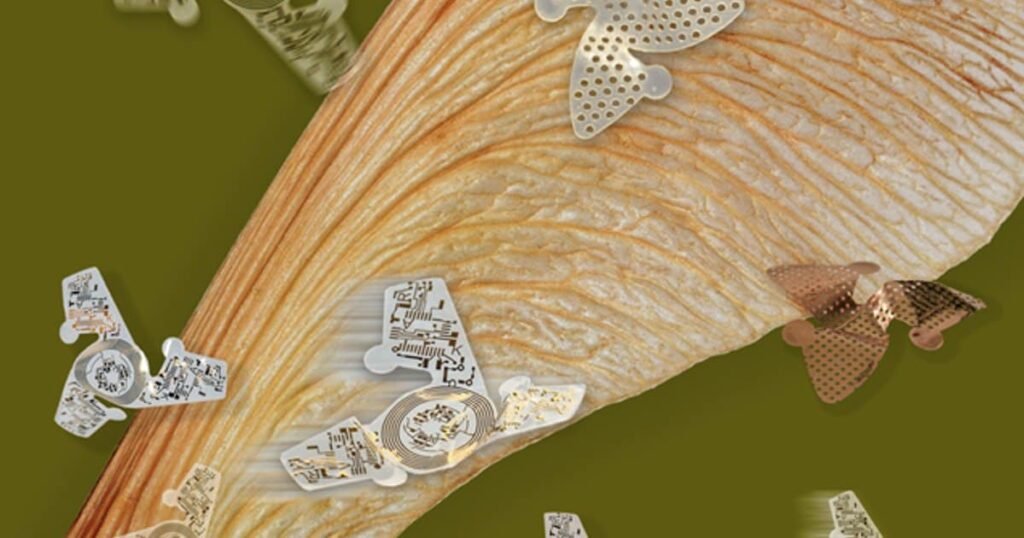Microflier Driven by Battery
Northwestern University engineers have developed the world’s first battery-free microflier design. The research and development process of what is being billed as the smallest-ever human-made flying structures, which are planned to eventually function as “large, distributed collections of miniaturised, wireless electronic devices,” or swarms, of environmental do-gooders, is detailed in an article published this week in Nature.
They’re supposed to be able to transport data, scan their environment, and communicate wirelessly. Air quality monitoring (and potential interactions with weather formations), airborne disease spread control, automated seed dispersal for agriculture, non-intrusive wild-life monitoring, explosive detection solutions for law enforcement, as massive data dispersal systems or as mass surveillance mechanisms and tools for biological warfare right now are just some of the possibilities for these swarms.
Will it be Misused?
While technology is often said to be neutral by nature, human use of it is another thing completely, as time and history have proved. Doomsday scenarios for wonder technology are undoubtedly plausible, as Black Mirror has demonstrated with a similar concept. However, the benefit of such fantasies is that they show us exactly what we should avoid in our interactions with technology, allowing us to focus on its benefits instead.
The impotent design of the microchips was inspired by the samara fruit, which are free-falling propeller seeds from the maple tree. There are no controlled boosters or anything like that on these chips. Rather, the small electronics are moved and sustained solely by air currents. Perhaps gliders rather than microfliers would be a more suitable term, but we’re not Northwestern scholars.
What makes it Fly?
As these structures descend through the air, the contact between the air and those wings causes a rotational motion that provides a very steady, slow-falling velocity as per one of the engineers behind the gadgets, John A. Rogers.
Computer modelling was used to optimise the microfliers, seeking for the best design that would allow them to fall gently and spread widely. Yonggang Huang, the computer model creator, remarked, “The computational modelling permits a rapid design optimization of the fly structures that delivers the least terminal velocity. Try-and-error tests make this impossible.”
What took to Develop it?
The engineers began by creating a 2D, planar basis for the real fliers, which houses all of the electronics. Sensors, power sources, antennas for wireless communication, and embedded memory to store data are among the electronics components that can be customised and are packed with ultra-miniaturized technology.
Planar techniques are the bread and butter of the semiconductor manufacturing business, therefore this is very critical for mass manufacturing capabilities. Because all present semiconductor devices are created in planar layouts, their method of generating 3D structures from 2D predecessors is powerful. They can employ the consumer electronics industry’s most modern materials and production technologies to create entirely standard, flat, chip-like designs. Then, using concepts similar to those of a pop-up book, they simply turn them into 3D flying shapes.

Nature Defying
When the base is relaxed, it commences “a controlled buckling process (…) that causes the wings to “pop up” into precisely specified three-dimensional structures.” The microfliers must be released into the air; the higher they are launched, the greater their potential for dispersal. Furthermore, the slower the microfliers descend, the further they can scatter from the release point. As a result, one of the engineers’ main objectives was to extend the flight time.
Roger said that they believe that they have defeated nature. At least in the sense that they’ve been able to create structures that have more stable trajectories and slower terminal velocities than equivalent seeds from plants or trees.
Is it all add-on to Electronic Waste?
But, if this type of technology is developed further and put into practice, what will become of all the electronic waste? Should swarms of these microfliers simply fall to the ground, crushed beneath our footwear as we sprint to the Metro? Northwestern University has also conducted research into transitory electronics, which are electronics that are biodegradable in nature (about which NIKE is working on for their shoes) after they have served their purpose.
“When exposed to water, we create such physically transitory electronics systems employing biodegradable polymers, compostable conductors, and dissolvable integrated circuit chips that spontaneously degrade into environmentally benign end products,” Roger explained. “We understand that recovering huge collections of microfliers might be challenging. These ecologically resorbable versions disintegrate spontaneously and harmlessly to address this concern.”
It’s still time that how will they be using them, but yeah, it’s an interesting invention.
